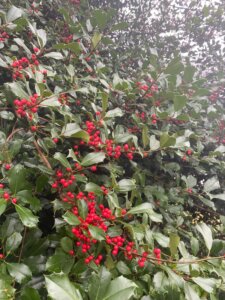
The U.S. holiday season traditionally kicks off with Thanksgiving and its televised parade extravaganzas (e.g., Macy’s and Philadelphia). Both feature marching bands, lavishly decorated floats, giant balloons and (Oh boy!) Santa Claus. We are old enough to remember watching the parades on black & white sets. All of that was great fun for our kids too; less so for our grandkids who somehow acquired a streak of cynicism in their teens that I can’t recall before. That’s OK. Christmas is big enough to include both the sacred and secular in its bosom; not to mention the remnants of Pagan traditions dredged up from the past. The latter are best represented by traditional Christmas plants. Here are our own favorites.
Poinsettia
Poinsettia (Euphorbia pulcherrima) is a shrub-to small tree-sized plant. The winter bloomer hails from Mexico and Guatemala where it was considered by Aztecs to be a symbol of purity and was cultivated as a medicinal plant. The actual flowers are small, green or yellow, and are concentrated in the center of a bunch of leafy bracts at the tip of each stalk. The bracts turn bright red and are typically mistaken for flower petals. This is how they appear when brought home for the holidays. All well and good, except that when the plant is kept and nurtured the following year, no colored bracts. The trick is that the colors of the bracts are created by subjecting the plants to at least fourteen hours of absolute darkness (not even a night light) at a time for 6–8 weeks in a row prior to the holidays. They also need abundant light during the day for the brightest color.
Poinsettias are reputed to be poisonous (ASPCA link: https://www.aspca.org/pet-care/animal-poison-control/toxic-and-non-toxic-plants/poinsettia). So, keep pets and little ones away from them, if you don’t want a child, puppy, or kitty sick under the tree. If you have further questions can always “Ask a Garden Expert” on our Black Gold Page here https://blackgold.bz/ask-a-garden-expert/garden-questions-answered/

Photo Credit Jessie Keith
Christmas Cacti
The Christmas cactus (Schlumbergera bridgesii) should not be confused with the Thanksgiving cactus (Schlumbergera truncata). The common names refer to the time of year they usually bloom. Christmas cactus blooms from December through February. Thanksgiving cactus blooms in November and December. Despite appearances, neither plant is a cactus. Instead they are succulent epiphytes that live on tree branches in subtropical rain forests. So you must not treat them like a standard cactus, or your reward will be a dead plant. On the other hand, Christmas cactus is incredibly easy to start. Just pick off a Y-shaped piece and stick it in a pot of moist Black Gold© Succulent and Cactus Mix and you are done.
Plants should be kept in bright, indirect light. An east-facing window or a bright bathroom is ideal. Too much direct sunlight can bleach the sensitive leaves. A daytime temperature of 70°F (21°C) and an evening temperature of 60-65°F (15-18°C) is best. In the summer, Christmas cacti can be placed in a shady spot in the garden or in an unheated porch until temperatures get below 50°F (10°C). Keep them out of direct outdoor sunlight.

Photo Credit Jessie Keith
Holly
The genus holly (Ilex spp.) is the primary representative of the holly family, Aquifoliaceae. Popular decorative hollies with red berries and spiny leaves are Ilex aquifolium in the Old World and Ilex opaca in North America. In Europe, Holly branches have long been used to decorate homes in winter. The tree was seen as a fertility symbol and a charm against witches, goblins and the devil. And it was thought to be unlucky to cut down a holly tree. When British colonists arrived in North America, they were surprised to find holly was already present, similar, though a different species.
American holly grows as an understory tree in forests of south and southeastern United States, and reaches a height of 30 feet or more. With its dark green, prickly foliage, solid pyramidal shape, and abundant crops of red berries on female trees, American holly is a great asset to any yard or garden. With careful pruning, enough holly boughs can be cut to deck your halls quite nicely without damaging your tree. If you don’t have your own trees. Attempting to collect your own holly bought in the wild may be fruitless at best, as American holly is not a particularly common tree anywhere in its range. Attempting to gather holly on public land may also be illegal. If you ask nicely, a kindly understanding neighbor may allow you to take a few. Otherwise, I recommend checking with local Christmas tree merchants.

Photo Credit Jessie Keith
Whatever you come up with, we wish you the joy of the season. And, keep safe.
